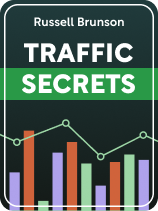

This article is an excerpt from the Shortform book guide to "Traffic Secrets" by Russell Brunson. Shortform has the world's best summaries and analyses of books you should be reading.
Like this article? Sign up for a free trial here.
Are you struggling to get traction on social media? Do you want to learn how to effectively market your business across various platforms?
In Traffic Secrets, Russell Brunson shares valuable insights on leveraging social media for maximum exposure. He offers four recommendations to help you pull more potential customers into your business funnel.
Keep reading for Brunson’s advice on how to market on social media.
Marketing on Social Media
Brunson explores how you can effectively leverage various social media channels for maximum exposure and to pull more potential customers into your business funnel. His advice regarding how to market on social media entails four recommendations:
- Use a variety of platforms
- Post frequently
- Don’t “sell” users at first
- Use call-to-action buttons
Tip #1: Use a Variety of Social Media Channels
Brunson writes that each platform has a different focus and offers different opportunities, so he advises that you tailor your content to each one so as to take advantage of their unique characteristics and audiences. By considering each platform’s idiosyncrasies, you can create consistently engaging content for your target customers.
He acknowledges that there are many different platforms you can use, but he mentions a few particularly influential ones you shouldn’t ignore:
- Instagram: an image-based platform ideal for visual storytelling—especially useful for products or services that have visually appealing elements
- Facebook: useful for targeted ads that allow business owners to reach potential customers based on likes, interests, and other demographics
- YouTube: the second largest search engine after Google, and the only platform where content can grow over time—videos don’t fall to the bottom of feeds like in other platforms, but instead can collect more and more views
(Shortform note: Marketing experts agree it’s important to diversify your social media platforms, noting that because each targets a different type of user, you’ll limit the reach of your messages if you focus on only one. For this reason, different content might perform differently across various platforms—what gets a strong response on Instagram, for example, might not resonate on Facebook or YouTube. Thus it’s important to not only try out messages on multiple platforms but also track what does well on each so that you can adjust your marketing strategy accordingly.)
Brunson advises that you aim for consistent branding across all channels you post on: Use the same logos, color schemes, and tones. This will make it easier for your customers to recognize you anywhere online.
Additionally, he encourages repurposing existing content across different formats—converting blog posts into podcasts or videos, for instance. This not only extends accessibility but can expose your message to fresh new audiences, ensuring that more streams of traffic head toward your business funnel.
(Shortform note: Consistency of both images and messages, as Brunson recommends, is a key component of creating a strong brand. The trick to branding in the digital age is to balance consistency against variety—too much consistency makes your brand seem overly curated and artificial, while too much variety risks losing your brand’s recognizable personality. Some research suggests that the size of your brand may affect this balance: Smaller brands benefit from consistency because they need to establish a brand association in the minds of consumers, but when larger brands are overly consistent, consumers see them as boring.)
Tip #2: Post Frequently
Brunson advises that you post content frequently on social media because it’s only when people see you a number of times that they’ll be compelled to investigate you further. He cautions, though, against posting incessantly because that can overwhelm your followers and lead them to tune out or unfollow you.
He also recommends engaging personally when possible by replying to comments and messages. This lends a human quality to your brand that potential customers respond well to.
(Shortform note: Brunson’s advice taps into the psychology of repetition and recognition. In Influence, Robert B. Cialdini notes that we’re more likely to engage with what’s familiar, which explains why, when you frequently post, people are more likely to be receptive to your message and even to reply and engage personally. Experts agree with Brunson, though, that there’s a fine line: Too much content can become intrusive, causing annoyance rather than appeal. Thus, finding the right balance is key to effectively using social media for engagement.)
Tip #3: Don’t “Sell” Until Users Visit Your Website
Brunson compares social media to a party—it’s a place to make friends, but not to overtly sell your wares (or you’ll be the least popular person at the party).
However, once you’ve made friends by interacting with people, you can metaphorically invite them over to your “house” (your website) by getting them to click on a link. Once they’ve chosen to enter your space, it’s appropriate to try to sell them something.
(Shortform note: The act of clicking a link to head to your “house,” or website, echoes Godin’s ideas in Permission Marketing, where consumers grant you permission to engage with them further. By visiting your space, they indicate they’re intrigued and trust you enough to learn more, so that product promotion becomes acceptable. Brunson and Godin both teach that good marketing isn’t about hard-selling right out of the gate—it’s about embracing a “permission-given” approach, building relationships and establishing trust before extending your marketing invitation.)
Tip #4: Use Call-to-Action Buttons
Brunson says that you must include a call-to-action (CTA) button on all of your posts. These are buttons that prompt visitors to take a next step—whether it be to visit your website, enter your sales funnel, or even just indicate that they “liked” your post. These work best when worded clearly but enticingly—think “grab yours” or “start saving,” instead of a more standard “submit.”
The advantage of CTA buttons is that not only do they prod visitors to become customers or to join your email lists, but they also help the algorithms of social media platforms know when people are connecting with your content. The algorithms will then reward your posts with greater exposure.
(Shortform note: The effectiveness of call-to-action buttons largely pivots on the psychological principle of scarcity, as noted by Robert Greene in The Laws of Human Nature: When things appear limited or in high demand, we tend to desire them more. That’s why you’ll often see buttons like “Buy now before it’s too late” or “Sign up now to reserve your spot.” It triggers our fear of missing out on an opportunity. Similarly, using persuasive language and a strong command verb like “buy,” “subscribe,” or “download” can also induce a sense of immediate action. This principle of scarcity and urgency motivates us to respond swiftly to these buttons.)

———End of Preview———
Like what you just read? Read the rest of the world's best book summary and analysis of Russell Brunson's "Traffic Secrets" at Shortform.
Here's what you'll find in our full Traffic Secrets summary:
- Tips to drive traffic to your online business
- How to find the right customers for your business
- The importance of social media for marketing






